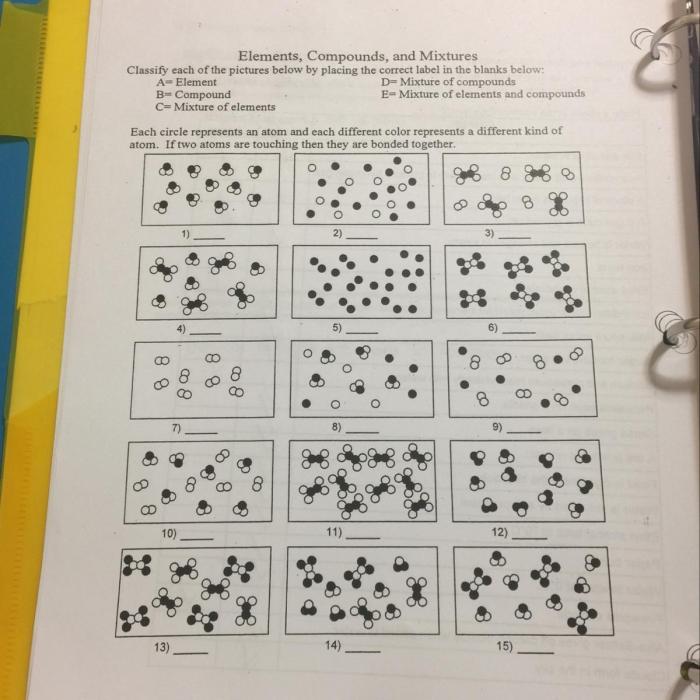Compounds mixtures and elements worksheet – Embark on an educational journey with our comprehensive Compounds, Mixtures, and Elements Worksheet. Dive into the fascinating world of chemistry as we explore the fundamental building blocks of matter and unravel their unique properties and behaviors.
This interactive worksheet delves into the concepts of compounds, mixtures, and elements, providing a solid foundation for understanding the composition and interactions of substances.
Compounds
A compound is a substance composed of two or more different elements chemically combined in fixed proportions. Compounds have distinct properties that differ from those of their constituent elements.
Examples of compounds include:
- Water (H 2O): composed of hydrogen and oxygen
- Sodium chloride (NaCl): composed of sodium and chlorine
- Carbon dioxide (CO 2): composed of carbon and oxygen
Compounds are formed through chemical bonds, which are forces that hold atoms together. The three main types of chemical bonds are:
- Ionic bonds: formed between atoms that transfer electrons, resulting in charged ions
- Covalent bonds: formed when atoms share electrons
- Metallic bonds: formed between metal atoms that share their valence electrons
Mixtures
A mixture is a combination of two or more substances that are not chemically combined. The substances retain their individual identities and can be separated by physical means, such as filtration or distillation.
Mixtures can be classified as either homogeneous or heterogeneous.
- Homogeneous mixtures are uniform throughout, with the same composition in all parts.
- Heterogeneous mixtures are not uniform, with different compositions in different parts.
Examples of mixtures include:
- Salt water (a homogeneous mixture of salt and water)
- Sand in water (a heterogeneous mixture)
- Air (a homogeneous mixture of nitrogen, oxygen, and other gases)
Elements
An element is a substance that cannot be broken down into simpler substances by chemical means. Elements are the fundamental building blocks of matter and are represented by their chemical symbols.
Examples of elements include:
- Hydrogen (H)
- Oxygen (O)
- Sodium (Na)
The periodic table organizes elements based on their atomic number and chemical properties.
Comparing Compounds, Mixtures, and Elements: Compounds Mixtures And Elements Worksheet

The following table compares the properties of compounds, mixtures, and elements:
| Property | Compound | Mixture | Element |
|---|---|---|---|
| Chemical composition | Fixed proportions of different elements | Variable proportions of different substances | Single type of atom |
| Physical properties | Unique properties that differ from constituent elements | Properties similar to constituent substances | Unique properties for each element |
| Chemical reactions | React to form new compounds | Do not react chemically | React with other elements to form compounds |
Worksheet Activities
Activity 1: Identifying Compounds, Mixtures, and Elements
Identify the following substances as compounds, mixtures, or elements:
- Water
- Salt
- Oxygen
- Sand
- Air
Activity 2: Classifying Mixtures
Classify the following mixtures as homogeneous or heterogeneous:
- Salt water
- Sand in water
- Air
Activity 3: Analyzing Chemical Formulas
Analyze the following chemical formulas to determine the elements present and their proportions:
- NaCl
- CO 2
- H 2O
Frequently Asked Questions
What is the difference between a compound and a mixture?
A compound is a substance composed of two or more elements chemically combined in fixed proportions, while a mixture is a combination of two or more substances that are not chemically bonded and retain their individual properties.
How can I identify an element?
Elements are pure substances that cannot be broken down into simpler substances by chemical means. They are represented by unique chemical symbols, such as H for hydrogen or Au for gold.
What is the periodic table, and how is it organized?
The periodic table is a tabular arrangement of chemical elements organized by their atomic number, electron configuration, and recurring chemical properties. Elements are arranged in rows (periods) and columns (groups) based on their similarities.